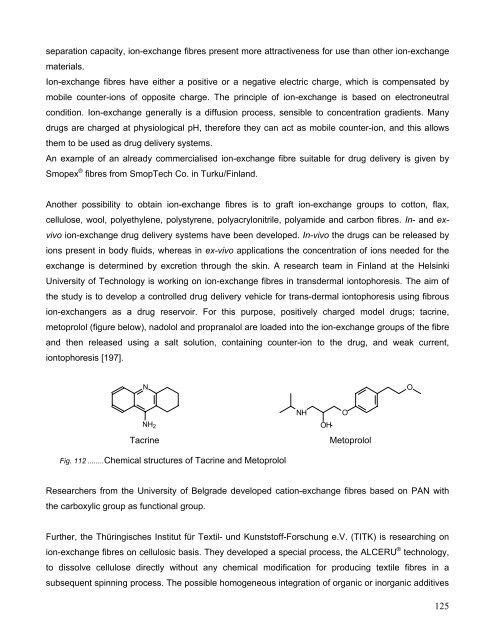Clevertex - Grado Zero Espace Srl
Clevertex - Grado Zero Espace Srl
Clevertex - Grado Zero Espace Srl
You also want an ePaper? Increase the reach of your titles
YUMPU automatically turns print PDFs into web optimized ePapers that Google loves.
separation capacity, ion-exchange fibres present more attractiveness for use than other ion-exchange<br />
materials.<br />
Ion-exchange fibres have either a positive or a negative electric charge, which is compensated by<br />
mobile counter-ions of opposite charge. The principle of ion-exchange is based on electroneutral<br />
condition. Ion-exchange generally is a diffusion process, sensible to concentration gradients. Many<br />
drugs are charged at physiological pH, therefore they can act as mobile counter-ion, and this allows<br />
them to be used as drug delivery systems.<br />
An example of an already commercialised ion-exchange fibre suitable for drug delivery is given by<br />
Smopex ® fibres from SmopTech Co. in Turku/Finland.<br />
Another possibility to obtain ion-exchange fibres is to graft ion-exchange groups to cotton, flax,<br />
cellulose, wool, polyethylene, polystyrene, polyacrylonitrile, polyamide and carbon fibres. In- and exvivo<br />
ion-exchange drug delivery systems have been developed. In-vivo the drugs can be released by<br />
ions present in body fluids, whereas in ex-vivo applications the concentration of ions needed for the<br />
exchange is determined by excretion through the skin. A research team in Finland at the Helsinki<br />
University of Technology is working on ion-exchange fibres in transdermal iontophoresis. The aim of<br />
the study is to develop a controlled drug delivery vehicle for trans-dermal iontophoresis using fibrous<br />
ion-exchangers as a drug reservoir. For this purpose, positively charged model drugs; tacrine,<br />
metoprolol (figure below), nadolol and propranalol are loaded into the ion-exchange groups of the fibre<br />
and then released using a salt solution, containing counter-ion to the drug, and weak current,<br />
iontophoresis [197].<br />
N<br />
NH2<br />
Tacrine Metoprolol<br />
Fig. 112 ........Chemical structures of Tacrine and Metoprolol<br />
Researchers from the University of Belgrade developed cation-exchange fibres based on PAN with<br />
the carboxylic group as functional group.<br />
Further, the Thüringisches Institut für Textil- und Kunststoff-Forschung e.V. (TITK) is researching on<br />
ion-exchange fibres on cellulosic basis. They developed a special process, the ALCERU ® technology,<br />
to dissolve cellulose directly without any chemical modification for producing textile fibres in a<br />
subsequent spinning process. The possible homogeneous integration of organic or inorganic additives<br />
NH<br />
OH<br />
O<br />
O<br />
125

















